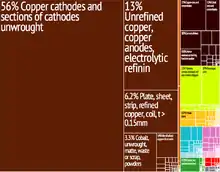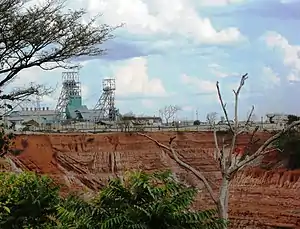Mining in Zambia
Taxes and fees

Research by the Overseas Development Institute on the taxes and fees in the Zambian mining sector during privatisation in the late 1990s and the subsequent boom in copper prices reviewed the taxes and fees for mining and compared it internationally for royalties and corporate income tax in other major mining countries. There were significant differences between countries in how these taxes are calculated and as a result, a comparison of 'headline rates' on their own provide limited insight into how would-be investors perceive the mining sector.[1]
They argued that perceptions offer an alternative and complementary approach to examine how Zambia compares from investors perspective to other countries. Using the Fraser Index component covering taxes and fees specifically, Zambia is in the middle of African countries, on par with South Africa, worse than Botswana, but better than the DRC. Perceptions that the taxes and fees for mining in Zambia is attractive does not necessarily mean the fiscal rates are themselves attractive (and vice versa) as investors tend to view taxes and fees in a broader context of risks to existing framework including its historical volatility and expectations regarding future changes, the possibility of negotiating a deal which is 'better' than the 'official' headline rates through exemptions or allowances, and other factors shaping the economics of the project for example if the geology is very favourable and extraction is low-cost, a firm will be able to accept a higher tax rate.[1]
They claim the diversity of 'drivers' behind investment illustrates the challenges of talking about the 'competitiveness' of a sector's taxes and fees in a narrow sense and different companies will weigh the above factors differently depending on access to low-cost import markets, further complicating an assessment of what an 'average' investor would consider attractive. Government and its development partners have a role to play in promoting policies that make investment more attractive, such as increasing the predictability of the taxes and fees whilst reducing the costs of mining, from infrastructure to skills and quality of geodata.[1]
They found Zambia is collecting and managing revenues from the mining sector, and that Extractive Industries Transparency Initiative has brought welcome transparency to the sector, but has limited scope. Debates have been less about whether revenue is going missing from companies to government, but more on whether Zambia is collecting what it is due. The main challenges therefore are for Zambia lie in reducing the complexity and opacity of mining sector fiscal framework, whilst boosting capacity of government agencies to monitor and collect fiscal contributions from the sector. Addressing these challenges can serve as a win-win for government, industry and development partners, by increasing taxes collected and satisfying those who are calling for greater contributions from the mining sector without further changes to an already-volatile taxes and fees.[1]
They call for a better understanding and an open discussion between the government and mining sector, into what the sector's broader contribution is and what its needs are, to create the space for planning, education, infrastructure beyond the taxes and fees that explicitly take into account the mining sector.[1]
Mining in Kitwe
Mopani Copper Mines
Mopani Copper Mines Plc (Mopani) is a joint venture company based in Kitwe as 95% of its operations are located there, comprising Glencore International AG (73.1%), First Quantum Minerals Ltd. (16.9%) and Zambian Consolidated Copper Mines Limited (10%). Mopani operates the Mufulira mine, smelter, concentrator and copper refinery and the Nkana mine, concentrator and cobalt plant. MCM produced 134,800 tons of copper and 2,040 tons of cobalt in 2003. MCM is investing in a number of oxide copper projects at several of its properties, including an in-situ leaching project at Mufulira and heap leaching at Nkana, and has achieved significant production increases at its underground mining operations in Kitwe and Mufulira. Copper production from internal sources was supplemented by the purchase of some 18,000 tons of copper in high-grade oxide concentrate bought from the Democratic Republic of the Congo. The company aims to rebuild the Mufulira smelter during 2004 and 2005, and also plans to add a new gas collection facility and acid plant at a total cost of US$95 million.
- Mufulira Mine
The largest underground mine in Africa, the Mufulira Mine employs 10,000 people; includes a concentrator, a refinery and a smelter; and produces 300,000 tons of copper each year through the process of open stopping. The copper is then taken to the concentrator.
- Mufulira Concentrator
The concentrator crushes ores coming from the Mufulira mine consisting of 46% copper, waters it, and then does the process of flotation so the waste material can be removed.
- Mufulira Smelter
The smelter melts the copper mixed with limestone in the Isasmelt furnace. The copper is pressurised by the air, then oxidised, and finally poled. The copper is then taken to the refinery.
- Mufulira Refinery
The copper is cast into anodes so the process of electrolysis can take place during refining.
- Nkana Mine

Nkana mine is one of the largest in Africa, a copper mine located 1 km south-west of Kitwe. The mine is underground as well as open pit and is in operation since 1932 and has produced 6,000,000 tons of copper so far. Its reserves underground include 69,000,000 tons of grading, 16,000,000 tons of copper, and 98,000 tons of cobalt. Its resources include 126,000,000 tons of grading, 43,000,000 tons of copper, and 300,000 tons of cobalt. Copper and cobalt mineralisation occur within the ore shale. Copper mineralisation in the deposits changes from mostly chalcopyrite in the South Orebody, to chalcopyrite-bornite in the Central area and to bornite-chalcopyrite at Mindola. Cobalt occurs as carrollite and cobaltiferous pyrite in approximately equal proportions. The mine produces copper and cobalt from three sources: Mindola Shaft, Central Shaft and South Orebody Shaft. Vertical crater retreat is the predominant mining method while sublevel open-stopping and sublevel caving methods are also used. Other metallurgical facilities, under a management contract by an affiliate of the Anglo American Group, include the Nkana smelter (not owned by Mopani), acid plant (not owned by Mopani) and copper refinery (not owned by Mopani). There is extensive mine tailings around this mine.
- Nkana Concentrator
Nkana Concentrator of Mopani mines, located in Kitwe, treats copper-cobalt sulphide ore using a bulk flotation and segregation flotation flowsheet to produce separate copper and cobalt concentrates. Nkana Concentrator is the most important mineral processing unit of Mopani, as it contributes about 65% of cobalt concentrates treated at the Nkana and Chambeshi Cobalt plants to produce high purity cobalt metal.
- Cobalt Plant
The cobalt plant treats 65% of the cobalt concentrates to produce high purity cobalt metal. The two cobalt plants are Nkana Cobalt Plant and Chambeshi Cobalt Plant.
Konkola Copper Mines
Konkola Copper Mines (KCM) is the largest copper mining company in the country. Although based in Chingola, 15% of its operations—namely Nkana Refinery, Nkana Acid Plants and Nkana Smelter (the largest smelter in the nation) -- are located in Kitwe. The Nkana Smelter is the largest primary copper production plant in Zambia. The plant treats concentrates mainly from Nkana, Nchanga, and Konkola mines, which are wholly owned by KCM to produce up to 150,000 tons of new copper.
- Nkana Smelter
The smelter produces high grade anodes, which are electrolytically refined. Sulphur dioxide gas produced by the converters is converted into sulphuric acid which is then used at the Tailings Leach Plant in Nchanga for recovering oxide copper. The smelter also produces discard slag from the reverbs that is rich in cobalt which is stored for future reclamation. This smelter was part of the Konkola Copper Mine's operation at privatisation and has subsequently closed.
- Nkana Refinery
The Nkana Copper Refinery produces electrolytically refined copper in the form of cathodes. The copper meets the LME premium quality grade. The tankhouse has a capacity of about 180,000 tons of finished copper per annum.
- Nkana Acid Plants
There are two single contact sulphuric acid plants at Smelterco, namely the No. 3 and No. 4 plants. No. 3, the largest, is still operational. The plant has a design capacity of 1,050 tons of acid per day.
Rokana Mine
Rokana Mine is a mining company that owns Mindola Underground Mine, which mines minerals such as carrollite, chalcopyrite and libethenite. Other minerals mined are bornite, pyrite, chalcocite.
There is extensive mine tailings around this mine. See Copperbelt Province for the history of the copper-mining industry in this region.
Other mining
There are two small tailings dams right in the city centre. There are also small-scale emerald mines in the area.
Environmental issues
The Broken Hill Mine, which occupies a 2.5 km2 site just 1 km south-west of Kabwe town centre, is now closed. Metals are still foraged from old tailings by locals, but it is expected an industrious cleanup by a foreign company will commence shortly this year. A study by the Blacksmith Institute found Kabwe to be one of the ten worst polluted and deadliest places in the world due mostly to heavy metal (mostly Zinc, Cadmium and Lead) tailings making their way into the local water supply.[2]
See also
References
- Haglund, D. Zambia mining sector fiscal benchmarking and assessment, EPS-PEAKS (Economic and Private Sector Professional Evidence and Applied Knowledge Services), http://partnerplatform.org/?q9tdys54
- The Blacksmith Institute website accessed 1 March 2007.
External links
| Wikimedia Commons has media related to Mining in Zambia. |